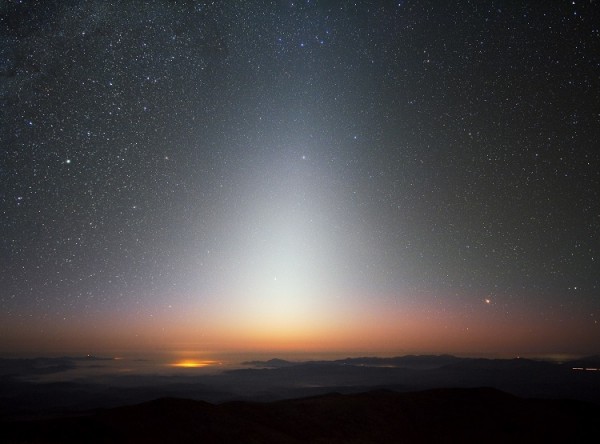Interstellar Dust Clouds Could be Hiding Earthlike Planets in Alien Star Systems
| Ana Verayo | | Nov 04, 2014 03:20 AM EST |
(Photo : Wikimedia) Alien zodiacal light caused by space star dust can prevent the detection of Earth-like planets in alien solar sytems
Astronomers believe space dust and grit from asteroid collisions plus comet remnants could be hindering the discovery of Earth-like exoplanets planets in alien solar systems.
This light reflected from dust and grime of asteroids and comets is called "exozodiacal light." This light prevents astronomers and scientists from detecting small exoplanets and their alien suns.
Like Us on Facebook
This exozodiacal light from far away galaxies was detected by the Very Large Telescope Interferometer (VLTI) located in Chile whose main goal is to study and observe 92 local star systems.
Data gathered from older studies is consolidated with newer ones to produce a clearer, more complete picture. These light formations surround probable habitable areas in nine alien star systems.
On Earth, zodiacal light can be seen in areas with completely dark skies as a white glow emanating from the horizon around the sun. Zodiacal light can be observed usually before sunrise or right after sunset.
This glow can be described as a triangular shape that seems to emanate directly from the sun itself.
Zodiacal light seen on Earth's skies from the sun is mainly caused by sunlight reflecting off gas and dust surrounding the sun. On the other hand, the exozodiacal light detected by the VLTI telescope marks the first time this event was witnessed on alien solar systems.
By combining images from four telescopes using the VLTI interferometer, this system allowed astronomers to study it in much detail. Scientists and astronomers have long observed star dust to investigate new alien worlds.
According to Olivier Absil of the University of Liège and the co-author of this study, this stardust light could yield a higher detection rate of alien planets even if it contains fainter dust undetectable in their survey. This interstellar dust can be considered an obstacle to future observations of Earth-like exoplanets.
Also known as false dawn and false dusk, zodiacal light can be often mistaken as the rising or setting sun.
This study was published on website of the European Organisation for Astronomical Research in the Southern Hemisphere.
Tagsexozodiacal light, earth-like planets, exozodiacal light alien planets star dust clouds, Interstellar Dust Clouds Could be Hiding Earthlike Planets in Alien Star Systems, space dust clouds hiding earth like planets, VLTI telescope
©2015 Chinatopix All rights reserved. Do not reproduce without permission
EDITOR'S PICKS
-

Did the Trump administration just announce plans for a trade war with ‘hostile’ China and Russia?
-

US Senate passes Taiwan travel bill slammed by China
-

As Yan Sihong’s family grieves, here are other Chinese students who went missing abroad. Some have never been found
-

Beijing blasts Western critics who ‘smear China’ with the term sharp power
-

China Envoy Seeks to Defuse Tensions With U.S. as a Trade War Brews
-

Singapore's Deputy PM Provides Bitcoin Vote of Confidence Amid China's Blanket Bans
-

China warns investors over risks in overseas virtual currency trading
-

Chinese government most trustworthy: survey
-

Kashima Antlers On Course For Back-To-Back Titles
MOST POPULAR
LATEST NEWS
Zhou Yongkang: China's Former Security Chief Sentenced to Life in Prison

China's former Chief of the Ministry of Public Security, Zhou Yongkang, has been given a life sentence after he was found guilty of abusing his office, bribery and deliberately ... Full Article
TRENDING STORY

China Pork Prices Expected to Stabilize As The Supplies Recover

Elephone P9000 Smartphone is now on Sale on Amazon India

There's a Big Chance Cliffhangers Won't Still Be Resolved When Grey's Anatomy Season 13 Returns

Supreme Court Ruled on Samsung vs Apple Dispute for Patent Infringement

Microsoft Surface Pro 5 Rumors and Release Date: What is the Latest?










